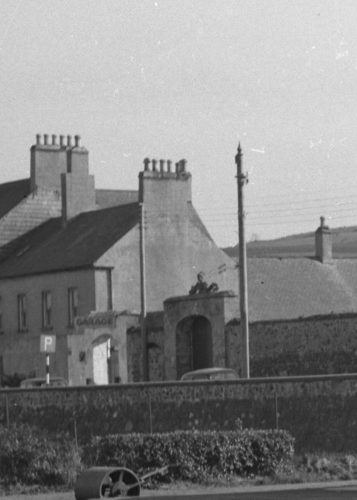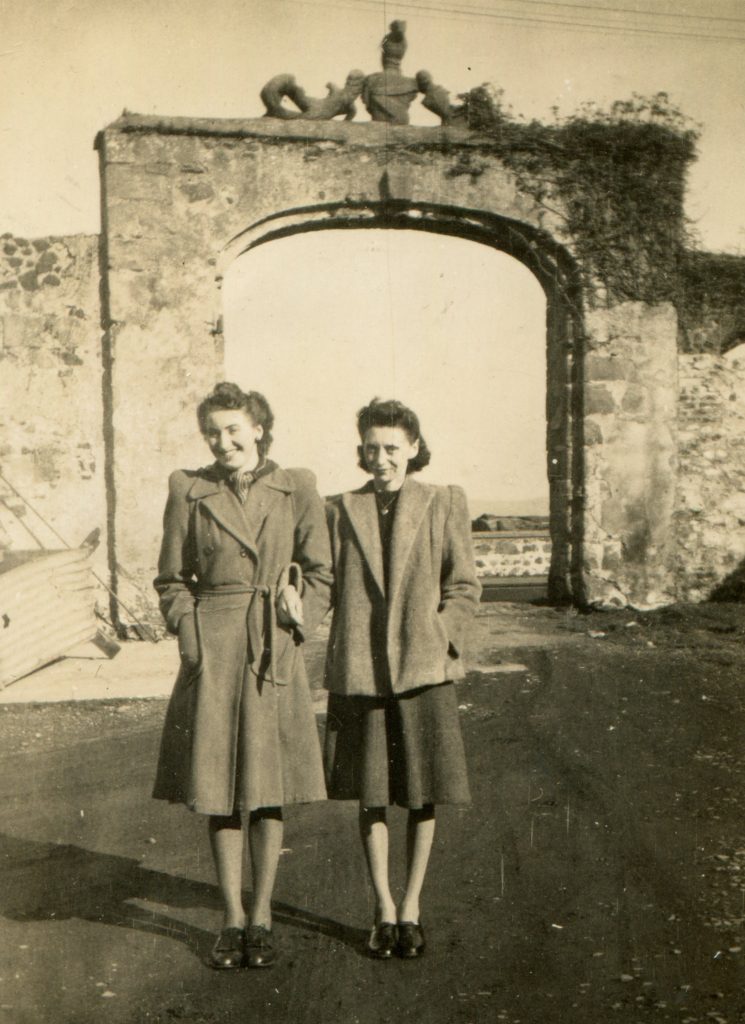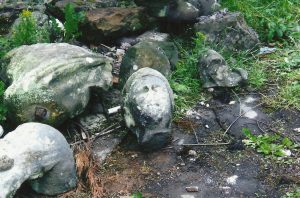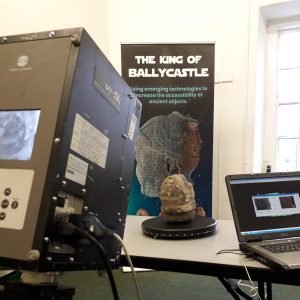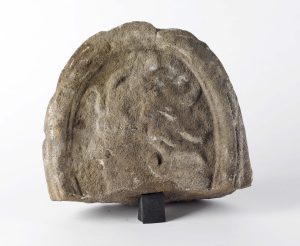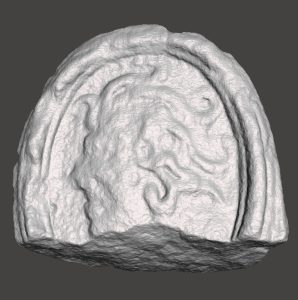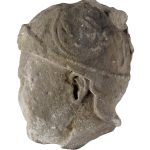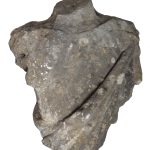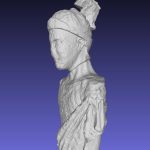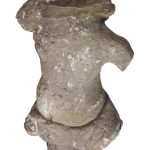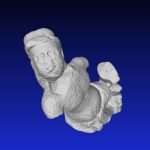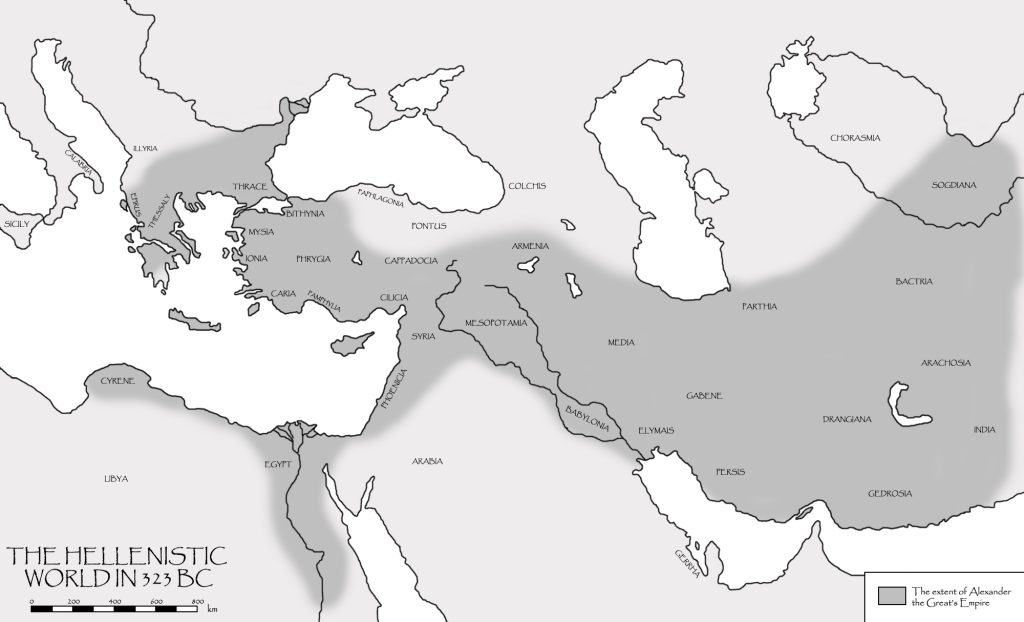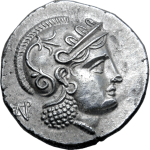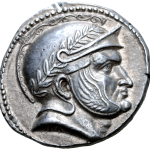13. King of Ballycastle

12. Gortnamoyagh Inauguration Stone
7th March 2023
14. King’s Fort
7th March 202313. King of Ballycastle
Until 1971, a mysterious statue group stood overlooking the tennis courts in Ballycastle. The statues were said to have been brought to Ireland from India and, according to local legend, depicted either river gods or, more commonly, a group of devils.
Now housed in Ballycastle Museum, recent research suggests that the statues, probably dated to the mid-19th century, were inspired by much older imagery. Rather than devils, the statuary probably show an armoured Greek king and two female figures (plausibly water nymphs); a joint legacy of the campaigns of Alexander the Great and the later British domination of India.
Of devils and kings
The Devil and his angels. That’s what we were told it was … I don’t know why but I always remember it as that. I must have been told when I was very young.
Adeline Burley (nee Anderson), 2019
As a child in the 1960s I remember the sculptures up on the archway at the back of the Boyd Manor House. I was scared walking past them to school. Grown-ups told us it was the Devil. It was like a ritual. We lined up on the footpath and it was like: ready, steady, go!
When the arch was demolished in 1971 the statues disappeared, both physically and mentally. New information has given me a different perspective.
Brigene Mc Neilly, 2020
When on the beach [the glass island] we were told, don’t look at the statues, they’re the devil and two bad angels…
Kathleen Bakewell, 2020
Often we would be passing the sculpture on top of the arch. We always had this thing that it was the Devil and we’d get past it as quick as we possibly could … Ye looked up at it occasionally, and ye didn’t look up at it too long, and ye just went on …
James McCurdy, 2019
After the arches were demolished in 1971, the broken statues were rescued by a local teacher, Matthew Scally, and passed to Cahal Dallat in 2006. After Cahal’s death they were purchased by Peter Molloy for the nominal sum of £1 and presented to the museum.
“I had a memory of the statues and heard a rumour that they were in Cahal’s back garden. As soon as I saw the head sitting on top of the pile, I knew they had to be saved.”
Peter Molloy, 2020
Local legends suggest that the statues represented Indian River Gods (linked to Major General Boyd’s military career in India) or a group of devils (being of heathen origin). Local historians Peter Molloy and Danny McGill originally suggested the sculptures might be Hellenistic (meaning ‘Greek-ish’, or heavily influenced by Greek culture). The initial Museum Service response was sceptical and for ten years they received little attention.
It was only after they were spotted by archaeologist Nic Wright, who questioned what Hellenistic sculptures would be doing in Ballycastle, that a new investigation began. The pieces have now been laser scanned by John Meneely, a specialist from Queen’s University Belfast.
- Laser scanning fragment 4
- Fragment 9
- Laser scan of fragment 9
The laser scanning and 3D imaging project led by Nic revealed much detail now lost to the naked eye and allowed the broken fragments to be joined back together. The statues depict a figure dressed in Hellenistic armour , and two female figures; a legacy of the campaigns of Alexander the Great and his successors in modern-day Afghanistan, Pakistan and India from the 4th century BC to the 1st century AD.
- Fragment 1
- Fragment 3
- Reconstruction of fragments 1, 2 and 3
- Fragment 4
- Fragment 5
- Reconstruction of fragments 4, 5, and 6
A legacy of Alexander?
Between 336 and 323 BC, Alexander the Great created an empire stretching from Greece to India. Following his death, the empire collapsed into competing Hellenistic successor states – Greek kings ruled over parts of Afghanistan, Pakistan and India for another 350 years.
Throughout this period, local and Greek traditions mixed to create a unique, Indo-Greek, culture. Several Indo-Greek kings are known to have become Buddhists, Greek gods were shown making Buddhist gestures and Hindu gods were depicted in Greek form.
The helmet on the Ballycastle statue reflects those worn by the gods Athena (Greek) and Skanda (Indian) on the coinage of the Indian king Sophytes (c.323-281 BC).
- Athena of a silver coin of Sophytes. Courtesy Roma Numismatics.
- Fragment 1
- Skanda of a silver coin of Sophytes. Courtesy Roma Numismatics.
The Boyd connection
The Boyd family inherited the stewardship of Ballycastle in 1690. Col. Hugh Boyd took over in 1711 and started the industrialisation of Ballycastle. However, following his death the Harbour silted up and the industries declined.
On coming of age in 1823, his great-great-grandson, also Hugh, joined the East India Company Army, where you didn’t have to buy a commission to be an officer. Over his career, Hugh worked his way up through the ranks to become Major General, serving in what is now northwest India and Pakistan. He retired after the Indian Rebellion (1857-1858), following which the East India Company Army was incorporated into the British Army.

Bengal troops on the line of march, by William Andrew Ludlow, c.1835, courtesy of the San Diego Museum of Art. Hugh Boyd served as an officer in the Bengal Native Infantry from 1823-1861.
Major General Boyd retired to Ballycastle a rich man. The statues, made of local Ballycastle sandstone, were mounted above an arch at the Boyd family Manor House on his return, a monument to his role as an agent of empire. The imagery appears to have been based of objects he saw and collected on his travels. The two females – resembling Greek nymphs or India yakshis, may represent the rivers Tow and Margy which merge close by the Boyd manor house before flowing into the sea.

To a large extent, Boyd’s known movements in India overlapped with the extent of Indo-Greek kingdoms.
The study of the Ballycastle statuary is ongoing, as we seek to fully understand the history of these enigmatic objects. The project to date has been made possible thanks to funding from the National Lottery Heritage Fund.
We would like to acknowledge the enthusiasm and hard work of the following people who helped bring this project to life: Brigene McNeilly, John Meneely, Brian Molloy, Peter Molloy, Patricia Perritt, Roger Perritt, Bryonie Reid, Gemma Reid, and Nic Wright.
Directions
59 Castle Street, Ballycastle, Co. Antrim BT54 6AS. The museum opens seasonally, check opening times at https://niarchive.org/ballycastlemuseum or by emailing cms@causewaycoastandglens.gov.uk.
Co-ordinates: 55.2004, -6.2517
This project is receiving financial support via the District Council Good Relations Programme.


